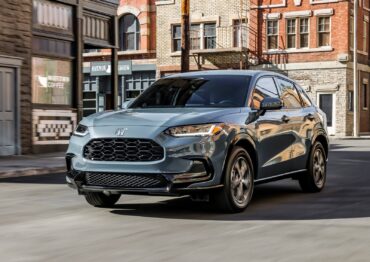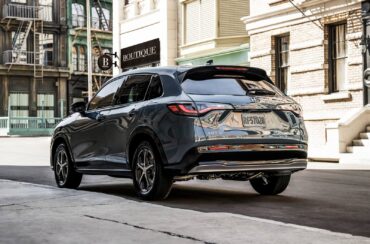 Model tested: 2023 Honda HR-V 5-door AWD EX-L
Model tested: 2023 Honda HR-V 5-door AWD EX-L
Engine: 2-liter inline four-cylinder
Transmission: continuously variable transmission (CVT)
Horsepower: 158
Torque: 138 lb.-ft.
EPA ratings: 25/city, 30/highway, 27/combined
Base price: $28,950
As tested: $30,590
Overview: The Honda HR-V, Honda’s smallest crossover, is one of the country’s bestselling small SUVs. Since the small crossover segment has exploded in popularity over the past few years, that’s saying something. Honda has positioned the HR-V to be an entry-level SUV competing against rivals like the Chevy Trailblazer, Toyota Corolla Cross, Mazda CX-30 and Volkswagen Taos.
Walkaround: The HR-V was totally redesigned for 2023 and is no longer based on the retired Fit, but on the larger Civic. Styling has been rounded, making it larger, less boxy, more refined and boasting more cargo room than the previous model. The exterior features wide LED lights front and rear, framed inlets and patterned grilles in the nose, an angled hatch and a smooth and clean roofline.
 Interior: The interior of the HR-V is one of its greatest strengths, with one of the roomiest cabins in the class. It offers ample space in both rows and soft-touch materials in most places. However, the trick storage — Honda’s so-called Magic Seat, which let users flip up the rear seat bottoms to store tall items on the floor — is history. The HR-V tech is similar to that of the new Civic. The standard touchscreen is 7 inches, and Honda’s new 9-inch touchscreen in our EX-L test-driver is easy to learn and simple to use. Both support Apple CarPlay and Android Auto, but only the EX-L allows you to go wireless. The HR-V doesn’t offer an integrated navigation system, so you’re out of luck venturing off the beaten path without cell service. Seating adjustments for the driver are relatively limited but offer a good range of motion. There is no lumbar support adjustment, which was surprising — and disappointing — especially on our fully loaded EX-L. Visibility from the cabin is good in all directions. Honda doesn’t offer a surround-view camera system, but the rearview camera offers multiple viewing angles, which is a plus.
Interior: The interior of the HR-V is one of its greatest strengths, with one of the roomiest cabins in the class. It offers ample space in both rows and soft-touch materials in most places. However, the trick storage — Honda’s so-called Magic Seat, which let users flip up the rear seat bottoms to store tall items on the floor — is history. The HR-V tech is similar to that of the new Civic. The standard touchscreen is 7 inches, and Honda’s new 9-inch touchscreen in our EX-L test-driver is easy to learn and simple to use. Both support Apple CarPlay and Android Auto, but only the EX-L allows you to go wireless. The HR-V doesn’t offer an integrated navigation system, so you’re out of luck venturing off the beaten path without cell service. Seating adjustments for the driver are relatively limited but offer a good range of motion. There is no lumbar support adjustment, which was surprising — and disappointing — especially on our fully loaded EX-L. Visibility from the cabin is good in all directions. Honda doesn’t offer a surround-view camera system, but the rearview camera offers multiple viewing angles, which is a plus.
Behind the wheel: Our driving impressions are mixed. The 2023 HR-V nonturbocharged 2-liter four-banger is the least “new” thing about it, although the 158 horses and 138 lb.-ft. of torque represent jumps of 17 horsepower and 11 lb.-ft. Ride comfort is good, and while the HR-V doesn’t smooth out all the road bumps, it does a commendable job of softening them. We also appreciated how quiet the cabin is, keeping road, wind and other noises minimal on a trip to Eastern Washington. The overly light steering took some getting used to, but it does have smooth and responsive brakes and surefooted handling. Acceleration around town is fine and on the highway is leisurely — doing the 0-60 drill in 10 seconds.
Bottom line: If Honda made its excellent 1.5-liter turbo engine available to the HR-V, it would be a vast improvement. As far as design, the HR-V has definitely matured over its predecessor and sports a much more substantial and upmarket feel. But the small SUV segment features some impressive competition, so the question becomes, has the new HR-V evolved enough to compete with the best?










